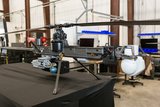US Army tests GBSAA system
he US Army has been testing the Ground Based Sense And Avoid (GBSAA) system at its Dugway Proving Ground, it announced on 10 May. The system will allow military operators of UAVs to fly within the National Airspace Space (NAS).
A ground-based radar inputs data to the GBSAA Traffic Display, while on-board aircraft transmitters broadcast position. Data from three different radars are fused and compared to data from the aircraft. A human ground based operator (GBO) monitors the traffic display for aircraft positions, warnings and system health.
The display exhibits concentric rings with distances of two, four and six miles outward, with the UAV at the centre. Aircraft within the four mile ring with a threatening projected trajectory are tagged yellow and prioritised on the alert display. The tag becomes red at the two mile ring if the threat increases, with audio-visual alerts sounded on the alert display.
The alert display notifies the GBO of potential aircraft conflicts monitored by the GBSAA system. The GBO communicates with the aircraft operator directly.
John Innes, test lead, said: ‘The warning system allows, at the minimum, one minute to take corrective action. In actual practice, operators would have longer time to take action.’
The new GBSAA removes the need for a chase plane or ground observer to fly UAVs within the NAS. Developers will return to the testing ground in the autumn of 2016 to complete the final part of the last test, and to conduct one full test. Innes expects continued testing at Dugway as changes and issues within the GBSAA are explored or developed.
At present, the GBSAA is solely for military use and there are no plans to extend it to the commercial sector. GBSAA testing has been successful enough so far for the army to decide to field it at five major stateside installations. The air force and marines have also expressed interest in fielding the system at one of their US installations.
More from Uncrewed Vehicles
-
![What's next for the Pentagon after the Replicator programme?]()
What's next for the Pentagon after the Replicator programme?
Although the Replicator initiative has made several accomplishments, there are still multiple gaps to plug across the US Department of Defense (DoD) and its services.
-
![Cummings Aerospace showcases Hellhound loitering munition designed for US Army’s LASSO programme (video)]()
Cummings Aerospace showcases Hellhound loitering munition designed for US Army’s LASSO programme (video)
Cummings Aerospace presented its turbojet-powered Hellhound loitering munition at SOF Week 2025, offering a man-portable solution aligned with the US Army’s LASSO requirements.
-
![SOF Week 2025: PDW unveils attritable FPV drone for SOF operations at scale]()
SOF Week 2025: PDW unveils attritable FPV drone for SOF operations at scale
PDW has revealed its Attritable Multirotor First Person View drone at SOF Week 2025, offering special operations forces a low-cost, rapidly deployable platform for strike and ISR missions, inspired by battlefield lessons from Ukraine.
-
![SOF Week 2025: Teledyne FLIR white paper provides guidance on reusable loitering munitions]()
SOF Week 2025: Teledyne FLIR white paper provides guidance on reusable loitering munitions
Teledyne FLIR is highlighting the emerging requirements for 'recoverable and re-usable' loitering munitions across the contemporary operating environment during this week’s SOF Week conference in Tampa, Florida.
-
![SOF Week 2025: Kraken Technology group debuts K3 Scout USV in North America]()
SOF Week 2025: Kraken Technology group debuts K3 Scout USV in North America
High-performance maritime industry player Kraken Technology Group, based in the UK, has used the SOF Week conference in Tampa, Florida this week to debut its K3 Scout uncrewed surface vessel (USV) to the North American market.
-
![Palladyne AI and Red Cat to demonstrate capabilities for autonomous drone swarms to the US military]()
Palladyne AI and Red Cat to demonstrate capabilities for autonomous drone swarms to the US military
Red Cat and Palladyne AI recently conducted a cross-platform collaborative flight involving three diverse heterogeneous drones.

























